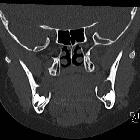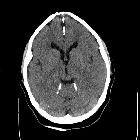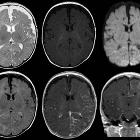nevoid basal cell carcinoma syndrome









Gorlin-Goltz syndrome (also known as the basal cell nevus syndrome, nevoid basal cell carcinoma syndrome, or just Gorlin syndrome) is a rare phakomatosis characterized by multiple odontogenic keratocysts (OKC), multiple basal cell carcinomas (BCC) and other abnormalities.
Epidemiology
The condition is thought to occur in ~1 in 60,000 live births while 0.4% of patients with basal cell carcinoma are estimated to have Gorlin syndrome. ~2% and 22% of patients with basal cell carcinoma younger than 45 years and 19 years of age, respectively, are estimated to have the syndrome.
Clinical presentation
- multiple basal cell carcinomas, often at puberty and in adolescence
- craniofacial anomalies
- odontogenic keratocysts, often multiple
- frontal bossing
- hypertelorism: 5%
- macrocephaly
- calcified falx cerebri
- calcified tentorium and petroclinoid ligaments
- cleft lip
- ocular defects including:
- coloboma of the iris
- microphthalmia
- bridging of the sella turcica
- high arched palate
- agenesis of the corpus callosum (occurs in ~10% of cases)
- musculoskeletal anomalies
- shortened 4 metacarpal bones
- bifid rib or other rib abnormality (fusion, partial agenesis, etc.)
- palmar and plantar pitting: defects of basal cell maturation
- neoplasms/hamartomas
- medulloblastoma: especially in males (M:F ~3:1)
- calcified ovarian fibroma
- lymphomesenteric cysts
- fetal rhabdomyoma
- cardiac fibroma(s)
Pathology
Genetics
It is an autosomal dominant syndrome with complete penetrance and variable expressivity. It is related to a mutation in the PTCH tumor suppressor gene on chromosome 9, which encodes for the "Sonic Hedgehog" receptor . 35-50% of affected individuals are the result of new mutations. Individuals with the syndrome are sensitive to ionizing radiation, with one study showing accumulation of p53 in exposed cells . Patients with Gorlin syndrome may be hypersensitive to and contraindicated from receiving radiation therapy.
Diagnosis
A clinical diagnosis can be made using major and minor criteria. To make the diagnosis, either two major or one major and two minor criteria must be met.
Major criteria
- basal cell carcinoma: >2 or 1 under the age 20
- odontogenic keratocysts (see case 1)
- palmar pits: 3 or more
- bilamellar calcification of the falx cerebri
- rib anomalies: bifid rib (see image), fused, splayed
- first degree relative with Gorlin syndrome
Minor criteria
- macrocephaly
- frontal bossing, cleft lip or hypertelorism
- Sprengel deformity, pectus excavatum or pectus carinatum, syndactyly
- bridging of the sella turcica, hemivertebrae, flame-shaped osseous radiolucencies
- ovarian fibroma
- medulloblastoma
History and etymology
It was described by Robert James Gorlin (1923-2006) and Robert William Goltz (1923-2014) in 1960 , although cases had been reported in the literature prior to this.
Siehe auch:
- Pectus carinatum
- Pectus excavatum
- Cherubismus
- Gabelrippe
- Medulloblastom
- Hypertelorismus
- frontal bossing
- Makrozephalie
- Syndaktylie
- Lippen-Kiefer-Gaumen-Spalte
- Keratozystischer odontogener Tumor
- Halbwirbel
- Kolobom
- Mikrophthalmus
- Fibrom des Ovars
- Phakomatosen
- Dysgenesie des Corpus callosum
- kardiales Fibrom
- lytische Läsionen der Mandibula
- Läsionen der Mandibula
- Trichoepitheliom
- shortened 4th metacarpal bones
und weiter:
- angeborene Wirbelanomalien
- Café-au-lait-Fleck
- subkutane Verkalkungen
- orbital hypertelorism
- Basaliom
- conditions involving skin and bone
- Verkürzung Metakarpale vier oder fünf
- Greig-Syndrom
- short metacarpals (mnemonic)
- Goltz-Gorlin-Syndrom
- keratocystic odentogenic tumour
- Zyste Maxilla
- keratocyst
- osteogenic jaw cyst
- diffuse Duraverkalkungen

 Assoziationen und Differentialdiagnosen zu Gorlin-Goltz-Syndrom:
Assoziationen und Differentialdiagnosen zu Gorlin-Goltz-Syndrom:



















